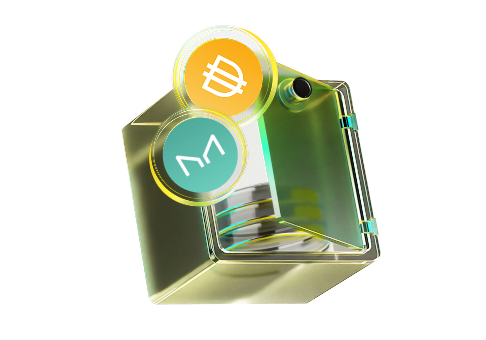What is MakerDAO and How Does DAI Work
MakerDAO stands as one of the oldest and most successful DeFi protocols on Ethereum. It operates as a Decentralized Autonomous Organization (DAO) that manages the creation and stability of DAI, a decentralized stablecoin. The protocol functions entirely through smart contracts without central authority control.
DAI differs from centralized stablecoins like USDT or USDC in a fundamental way. While those stablecoins rely on traditional bank reserves, DAI maintains its dollar peg through cryptocurrency collateral locked in smart contracts. This design makes DAI transparent, censorship-resistant, and fully auditable on the blockchain. Users can verify every DAI token's backing at any time.
The protocol generates over $80 million in annual revenue, making it one of the most profitable DeFi applications. Nearly 800 projects have integrated DAI into their services. This widespread adoption has established DAI as a cornerstone of the DeFi ecosystem.
Review MKR Price on LBank
MKR() Prijs
De huidige prijs van MKR() is $0, met een wijziging van % in de afgelopen 24 uur en een wijziging van % gedurende de periode van Afgelopen zes maanden. Voor meer details kunt u nu de MKR prijs bekijken.
Governance Structure and MKR Token
MKR token holders control MakerDAO through on-chain voting. They make decisions about risk parameters, collateral types, and protocol upgrades. The governance system operates transparently with all votes recorded on the blockchain.
Key governance responsibilities:
- Setting stability fees and DSR rates
- Approving new collateral types
- Adjusting liquidation ratios and risk parameters
- Managing the protocol surplus and deficit
- Implementing technical upgrades
MKR serves dual purposes as both governance token and backstop for system losses. During extreme events where liquidations don't cover bad debt, the protocol mints and sells MKR to recapitalize. This mechanism aligns MKR holder interests with protocol health.
The protocol uses surplus revenue to buy and burn MKR tokens. This creates deflationary pressure that rewards MKR holders when the system performs well. The current MKR market cap stands at $1.3 billion with continuous buybacks from protocol revenue.
The History and Evolution of MakerDAO
The history of MakerDAO begins with Rune Christensen, a Danish entrepreneur who started exploring decentralized finance concepts around 2014. In early 2015, he introduced the first version of the idea on Reddit under the name “eDollar.” His vision was to build a system on Ethereum that could issue a dollar-pegged stablecoin independent of banks or centralized issuers. This idea laid the foundation for what later became the MakerDAO protocol and the DAI stablecoin.
MakerDAO launched its first version of DAI in 2017 with a single-collateral design backed only by ETH. This was a milestone for DeFi, as it created one of the first stablecoins governed on-chain. Two years later, the project upgraded to Multi-Collateral DAI, expanding collateral types to include tokens such as WBTC and USDC. This change made the system more resilient and allowed DAI to scale in both supply and adoption across the DeFi ecosystem.
Christensen has continued to play an active role in shaping MakerDAO’s direction. He has frequently contributed to governance discussions and major strategy proposals, including efforts to expand into real-world assets and the long-term Endgame plan. While MakerDAO operates as a decentralized protocol, his leadership has had a strong influence on its growth and evolution into one of the most important projects in DeFi.
Timeline of Important Milestones of MakerDAO
MKR Token Launch
Launch of MKR governance token
Single-Collateral DAI Released
Release of Single-Collateral DAI (SCD), accepting only ETH as collateral
Multi-Collateral DAI Upgrade
Upgrade to Multi-Collateral DAI (MCD), expanding collateral types
Stablecoins and wBTC Added
Integration of stablecoins and wrapped Bitcoin as collateral
RWA Expansion Begins
Major expansion into Real-World Assets (RWAs)
How DAI Maintains Its Dollar Peg
DAI uses multiple mechanisms to keep its price stable at $1. The system adjusts supply and demand through economic incentives rather than central bank interventions.
Over-collateralization forms the foundation of DAI's stability. Users must deposit more collateral value than the DAI they mint. For example, depositing $150 worth of ETH allows minting only 100 DAI. This buffer protects the system when collateral prices drop.
The Peg Stability Module (PSM) provides immediate price correction. Users can swap stablecoins like USDC for DAI at a fixed 1:1 ratio. When DAI trades above $1, arbitrageurs buy USDC, swap it for DAI through the PSM, and sell the DAI for profit. This process quickly brings the price back to $1.
Stability Fees act like interest rates on DAI loans. MakerDAO governance raises fees to make DAI creation more expensive when supply needs reduction. Lower fees encourage more DAI minting when demand increases. These fees must be paid in MKR tokens, which get burned permanently.
The DAI Savings Rate (DSR) offers another stability tool. DAI holders can lock their tokens to earn interest from stability fees. A higher DSR removes DAI from circulation by encouraging saving. A lower rate pushes DAI back into the market.
The Vault System and Liquidation Process
Users create DAI through a system called Vaults (formerly Collateralized Debt Positions). The process works like taking out a loan against your crypto assets.
First, users deposit accepted collateral into a Vault smart contract. The protocol then allows them to mint DAI against this collateral. Each collateral type has specific parameters including minimum collateralization ratios and stability fees. Users can add or remove collateral and mint or repay DAI as long as they maintain the required ratios.
The liquidation mechanism protects the system from under-collateralized positions. Each Vault has a liquidation ratio that triggers automatic liquidation if breached. For instance, an ETH Vault with a 150% liquidation ratio gets liquidated when the collateral value drops below 1.5 times the DAI debt.
During liquidation, the protocol auctions the seized collateral to cover the outstanding DAI plus a penalty fee. This process happens automatically through smart contracts. The penalty incentivizes users to maintain healthy collateralization levels and compensates the protocol for liquidation costs.
Real-World Assets Integration and Revenue Model
MakerDAO has dramatically shifted toward Real-World Assets in recent years. The protocol now holds a $2.34 billion RWA portfolio. This includes $1.14 billion in U.S. Treasury bonds and 500 million USDC earning yield through Coinbase Prime.
RWAs generated nearly 80% of MakerDAO's fee revenue over the past year, totaling $13.5 million. The yield from U.S. Treasury bills provides steady income that funds the DAI Savings Rate. This integration marks a significant departure from purely crypto-native collateral.
Revenue streams include:
- Stability fees from Vault owners
- Liquidation penalties from under-collateralized positions
- Yield from the RWA portfolio
- Trading fees from the Peg Stability Module
BlockTower Credit and 6s Capital Partners manage specialized vaults for RWA-backed loans. These partnerships bring traditional finance expertise into the DeFi space. The strategy has proven highly profitable but raises questions about decentralization.
MakerDAO vs Frax Finance Comparison

MakerDAO and Frax Finance represent different approaches to decentralized stablecoins. MakerDAO maintains its position as the established leader while Frax pushes innovation boundaries.
MakerDAO's sDAI offers 1.73 billion in supply with 5% yield. Frax's sFRAX provides 41 million supply but delivers over 6.5% yield. The yield difference reflects their distinct risk profiles and asset strategies.
MakerDAO generates over $80 million annual revenue compared to Frax's $20 million. But Frax demonstrates faster innovation with products like Frax bonds (FXB) and frxETH liquid staking. Both protocols plan to launch their own Layer 2 chains on Ethereum.
The key difference lies in their philosophies. MakerDAO prioritizes stability and scale through RWA integration. Frax focuses on crypto-native innovation and algorithmic market operations. Each approach offers unique advantages for different user needs.
Risk Factors and Future Challenges
Market volatility remains a constant threat to MakerDAO's stability mechanisms. Sharp crypto price drops can trigger cascading liquidations. The March 2020 "Black Thursday" event demonstrated this vulnerability when ETH crashed 50% in 24 hours.
Regulatory risk looms large over the protocol's future. Government actions against DeFi could target MakerDAO's operations or collateral assets. The heavy reliance on USDC creates particular exposure to regulatory decisions affecting Circle. Technical complexity barriers limit user adoption. Managing Vaults requires understanding of collateralization ratios, liquidation risks, and gas fees. New users often find the system intimidating compared to centralized alternatives.
Competition from other stablecoins continues intensifying. Centralized options offer simpler user experiences. New decentralized protocols promise better yields or innovative features. MakerDAO must balance stability with innovation to maintain its market position.
The protocol faces a fundamental tension between decentralization and profitability. RWAs generate substantial revenue but compromise censorship resistance. The community must decide whether financial success justifies centralization risks. This decision will shape MakerDAO's trajectory for years ahead.

